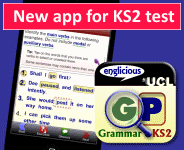Topic: Y2 GPaS (SPaG) Test
Relevant for the Year 2 GPaS test requirements, according to the UK National Curriculum. GPaS (Grammar, Punctuation, and Spelling) is also known as SPaG. Bear with us while we create more resources.
Englicious contains many resources for English language in schools, but the vast majority of them require you to register and log in first. For more information, see What is Englicious?

